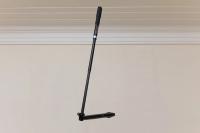Works



Installation Views
Press Release
EMANUEL ROSSETTI RELAY RUST August 10 – September 15, 2018
“Mathematics is the art of giving the same name to different things.” – Henri Poincaré
Continuities seem only able to realize themselves once they’ve met with certain contradictions embedded within their own logics, yielding up distinction. Over the course of his investigations, Emanuel Rossetti has developed something of an echo chamber wherein places, spaces, the passageways between them, swathes of time, architectures, sounds, representations, images, things both concrete and virtual, objects either mundane and recognizable or drawn from an abstract realm, three dimensional renderings, and more recently photographs, partake in an odd dance, whereby they find that they have been displaced and repeated, transformed and perverted, and ultimately granted a status wherein this process of gaining access to a distance from themselves offers them to an arena in which they can become figures of their own imaginary. Perhaps a tea kettle upon entering Rossetti’s theatre of entwisting modes of representative modeling will share its dream-space with a roller-coaster that does not exist beyond its depiction - but whose facticity is nevertheless valid, because thought of, with and through technologies of communication and virtual rendering.
In the current exhibition in Mexico City, a tea kettle is positioned as something of a lynch-pin for the show. While in previous instances it has been removed from its normative role as thing-you-use-to-heat-up-water, to a thing encountered yet unknown, by being passed back and forth between the space of the real and the virtual–establishing a vibration between its presence as readymade object and digitally rendered three-dimensional object (the real folded out of the virtual)–in this instance it has literally been inverted: polished to the point that it has now become reflective, affixed to a magnet suspended by a string from the ceiling, and hung upside down. Rather than being a thing displayed and depicted, it now reflects and mirrors what surrounds it, taking on the function of a “repeater-apparatus,” whereas before it had been the thing repeated by the three dimensional rendering program used in a previous exhibition at Jan Kaps in Cologne. Its curved surface, and the reflections it emits, rhymes with the bulbously warped spaces depicted in a previous run of eight sh-eye lens photographs shown earlier this year. The industrial magnet, typically used for retrieving tools from impossible to reach places on construction sites, has been coated with purple paint, turning it into something of an altered readymade. Two tropes of Rossetti’s practice converge in this arrangement: there is first the influence of an invisible force between things (magnetism), and then the diversion of a thing laden heavily with use-value away from its typical function.
In the next room a 360 degree panoramic camera with sh-eye lenses is suspended from the ceiling, with its image feed projected onto the wall. The equirectangular image generated by the camera in one sense provides what may be a more accurate view of the room than what can be known by the naked eye, and yet its effect is one of disorientation, amusing as much as it is vertiginous. Compounding its dizzying effect is the fact that the manner in which it is hung throws the camera and its subsequent image off kilter, which wobbles slightly as the air in the room shifts. I would venture that what is at stake with this piece reflects in many ways the historical condition we find ourselves in now, when it has become clear that the access to reality granted by technologies of representation can distort what we know about where we stand with the world, as much as it grants knowledge of it.
Finally, a strange zone of unknowing that underrides pictures, which are conventionally experienced as windows onto an outside world of facts, emerges in a new series of photograms. These works offer a glimpse of what could be understood as an inner life of photographs themselves. Trinkets and charms collected from a marketplace in Mexico City, through the explicitly cheap trick of the photogram method employed by Man Ray for his Rayograms, create strange worlds of ambiguous signage. While these works traffic in the same method of estranging the familiar Rossetti has worked with in previous works, the atmosphere they produce seems like a decidedly new zone when compared to Rossetti’s previous effects of distancing. While before Rossetti has deployed a vocabulary of objects, he seems now to have made his first entry into a realm of signs and symbols. These works offer a glimpse of the symbols themselves projected into a space in which they cease to refer, and become phenomena. Rather than positing the image as a vessel conveying facts to a viewing subject, the photograms seem to have their own urge towards relaying their own subjectivity, which has come about between the artist as a receiver of messages, and an image making process engaged in a discovery of its own hermetic language. – Roger van Voorhees

































